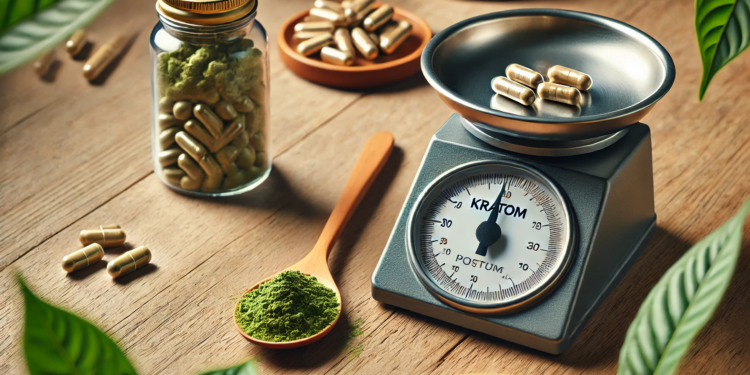When determining the right dose of kratom, factors like strain and desired effects often come to mind. However, one of the most important variables is body weight. Your weight significantly influences how kratom interacts with your system, affecting its potency and duration. In this guide, we’ll explore the relationship between kratom dosage and weight, helping you find the ideal dose based on your body size and tolerance level.
Why Body Weight Matters for Kratom Dosage
Kratom’s effects are largely dose-dependent, meaning the amount you take determines whether you feel energized, relaxed, or pain-management. Body weight is a critical factor because it influences how substances are distributed and metabolized in your body.
- Larger Individuals: Generally require higher doses of kratom to feel the same effects as smaller individuals due to increased body mass and a larger volume of distribution.
- Smaller Individuals: Often experience more pronounced effects with lower doses, as the substance has less mass to disperse through.
Choosing products from the ideal kratom vendor ensures consistent quality, allowing you to tailor your dosage accurately to match your body weight and avoid unwanted side effects.
General Dosage Guidelines Based on Weight

Below is a general guideline for kratom dosing by weight. Keep in mind that other factors, such as tolerance, strain, and desired effects, also play a role:
For Individuals Under 150 lbs (68 kg):
- Low Dose: 1-2 grams (mild effects).
- Moderate Dose: 2-4 grams (balanced effects).
- High Dose: 4-6 grams (strong, sedative effects).
For Individuals Between 150-200 lbs (68-91 kg):
- Low Dose: 2-3 grams (mild effects).
- Moderate Dose: 3-5 grams (balanced effects).
- High Dose: 5-7 grams (strong, sedative effects).
For Individuals Over 200 lbs (91 kg):
- Low Dose: 2-4 grams (mild effects).
- Moderate Dose: 4-6 grams (balanced effects).
- High Dose: 6-8 grams (strong, sedative effects).
How Weight Affects Kratom’s Duration and Potency
Your body weight doesn’t just influence how much kratom you need; it can also affect how quickly or slowly the effects kick in and how long they last:
- Larger Body Weight: Slower onset and longer duration due to the increased time it takes for kratom to be distributed through the body.
- Smaller Body Weight: Faster onset and shorter duration, as the substance is metabolized more quickly in smaller individuals.
Other Factors That Influence Kratom Dosage

While weight is a significant factor, other variables can also impact how much kratom you need:
1. Tolerance
If you’ve been using kratom regularly, you may require a higher dose to achieve the same effects. Taking tolerance breaks or rotating strains can help reset your tolerance.
2. Strain Type
Different strains have varying potency levels, which can affect the appropriate dose:
- White Vein: Best for low to moderate doses to enhance energy and focus.
- Green Vein: Offers balanced effects, ideal for moderate doses.
- Red Vein: Works well for higher doses, providing relaxation and pain management.
3. Desired Effects
- Low Doses (1-3 grams): Energizing and focus-enhancing effects.
- Moderate Doses (3-5 grams): Balanced mood enhancement and mild pain management.
- High Doses (6-8 grams): Sedative effects and strong pain management.
4. Individual Metabolism
People with faster metabolisms may process kratom more quickly, requiring slightly higher doses to maintain effects. Conversely, those with slower metabolisms may need less.
Best Practices for Adjusting Kratom Dosage by Weight
If you’re new to kratom, start with the lowest recommended dose for your weight range. Gradually increase the amount by 0.5-1 gram per session until you find your sweet spot. Accurate dosing is essential, especially when adjusting for weight. A digital scale ensures you’re taking the right amount and avoids the guesswork of using teaspoons or tablespoons.
Track how you feel after each dose. Note the onset time, duration of effects, and any side effects to fine-tune your dosage. Kratom can be dehydrating, particularly at higher doses. Drink plenty of water and pair your kratom with a healthy, balanced meal to support your body.
Even if your weight suggests you can handle higher doses, avoid exceeding 8 grams per session. High doses can lead to unwanted side effects like nausea, dizziness, or dependency.
Signs You’ve Taken Too Much Kratom
Regardless of your weight, taking too much kratom can result in side effects. Here’s what to watch for:
- Nausea or vomiting.
- Drowsiness or excessive sedation.
- Dizziness or lightheadedness.
- Restlessness or irritability.
If you experience any of these symptoms, reduce your dose and consider taking a break to allow your body to reset.
Conclusion: Personalize Your Kratom Dosage Based on Weight
Your body weight plays a significant role in determining your ideal kratom dose, but it’s only one piece of the puzzle. By considering weight alongside factors like strain type, tolerance, and desired effects, you can customize your kratom experience for maximum benefits. Always start with the lowest effective dose, measure accurately, and monitor your body’s response. With mindful use and proper dosing, kratom can be a valuable part of your wellness routine, tailored to your unique needs.


























































